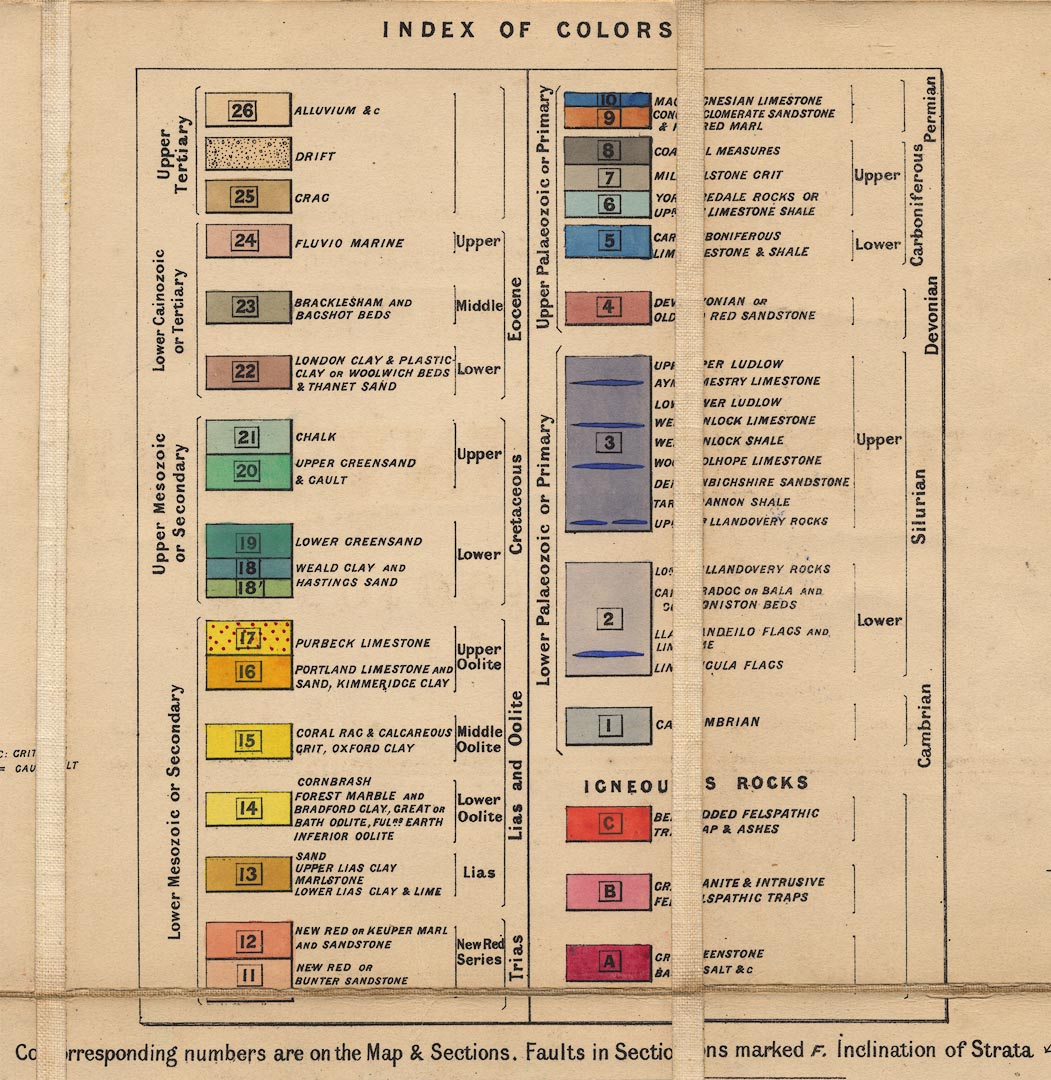


geologist
map maker
publisher

GEOLOGICAL MAP OF ENGLAND & WALES BY ANDREW C. RAMSAY, F.R.S.& G.S. Local Director of the Geological Survey of Great Britain, Professor of Geology in the Government School of Mines. ...
And at the bottom:-
London; Published by Edward Stanford, 6 Charing Cross, January 15th. 1866
Among the sources mentioned on the map are Professor Adam Sedgwick and Mr Ruthven for Cumberland and Westmorland.
Stratigraphy see:-
RMS1Geo.txt
up is N
scale

The map has a scale line; marked and labelled at 10 mile intervals. The 30 miles = 62.5 mm gives a scale 1 to 772485 assuming a statute mile. The map scale is about:-
1 to 770000
12 miles to 1 inch
lat and long grid

Printed in the map borders are scales of latitude and longitude; chequered at 10 minutes intervals, labelled at degrees. A graticule is drawn over the map at degree intervals.
sea plain

SOLWAY FRITH
Morecambe Bay
headlands
foreshore
sandbanks
lighthouses
A headland might be noticed, eg:-

St Bees Head
Foreshore shallows and sandbanks are indicated by dotted areas as in the Solway Firth.
Lighthouses might be labelled, for example on Walney Island and at St Bees Head:-
Light

Rivers are drawn by a wiggly line tapering upstream. Some rivers are labelled, eg:-
R. Eden
Liddel R.
Riv. Rawther
Bassenthwaite Wr.
Coniston Water
Crummock Water
Derwent Wr.
Devoke Wr.
Elter Water
Ennerdale Water
Grasmere L.
Haw Water [Haweswater]
Ha[w]s Water [Hayes Water]
Kentmere Tarn
Lily Tarn [Killington Reservoir?]
Lowes Water
Thirle Mere

Ulles Water
Wast Water
Winander Mere
Other lakes might be recognised, eg:-
Buttermere
Esthwaite Water
Rydal Water
hill hachuring
spot heights

Saddleback / 929
Cross fell / 968
Skiddaw
Helvellyn / 1108
Benson Knot

Gowbarrow Park

County boundaries are a fine dotted line, difficult to see under the geological colouring, continued along other features as at the River Eamont at Penrith. County areas are labelled, eg:-
WESTMORLAND

CARLISLE

Kirkby Kendal
Ambleside
hamlets

Bampton
Dent
Askham

A network of roads is drawn by double lines for larger roads, single lines for lesser roads. The double lines are mostly light bold, suggesting turnpikes?

Railways are drawn by a line with cross ties.

Canals are drawn by a bold line. In Cumbria the canals shown are:-
Lancaster Can.
Skin[.] Canal
perhaps:-
Skinburness Canal
table of strata

The purpose of this map is geology, which is indicated by heavy colouring, each area bounded by an engraved line. Looking closely at the tints it is possible to see that it is very careful hand colouring.


Larger areas are labelled with a number in a simple box. Colour and number refer to a table of strata printed upper right, below the map title.

Notice that the Ordovician does not figure in this table.
There are geological notes around the outside of the land area. For Cumbria there are:-
COAL WORKS BENEATH THE SEA
at Workington. And:-
RICH IRON ORE AT ULVERSTON
RED HEMATITE
both printed off the Duddon Estuary.
 Ramsay 1866
Ramsay 1866